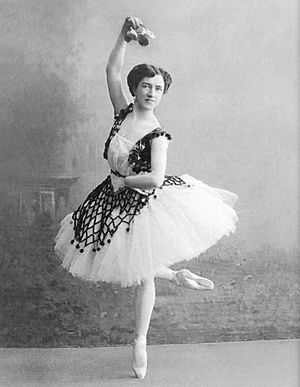Agrippina Vaganova facts for kids
Quick facts for kids
Agrippina Vaganova
|
|
|---|---|

Agrippina Vaganova in the pas de trois from Paquita. Saint Petersburg, circa 1910
|
|
| Born |
Agrippina Yakovlevna Vaganova
26 June 1879 |
| Died | 5 November 1951 (aged 72) Leningrad (Saint Petersburg), Soviet Union
|
| Occupation | Ballet dancer, teacher |
Agrippina Yakovlevna Vaganova (Russian: Агриппина Яковлевна Ваганова; June 26, 1879 – November 5, 1951) was a very important Russian and Soviet ballet teacher. She created the Vaganova method, which is a famous way of teaching ballet. This method came from the old Imperial Ballet School's teaching styles, especially those used by the main ballet master, Marius Petipa, in the late 1800s. Vaganova made these teaching ideas into a clear and effective system. Her book, Fundamentals of the Classical Dance (1934), is still a key textbook for learning ballet today. Her technique is one of the most popular ballet styles around the world.
Contents
Her Life and Ballet Journey
Agrippina Vaganova was born in Saint Petersburg, Russia. Her father, Akop Vaganov, was Armenian and worked at the Mariinsky Theatre. Her mother was Russian.
Vaganova's entire life was connected to the Mariinsky Ballet, which was first called the Imperial Ballet. This famous ballet company performed at the Mariinsky Theatre in Saint Petersburg. In 1888, she joined the Imperial Ballet School. This school was a great place for classical dance, started by Anna of Russia and supported by the Russian Tsars. She finished her advanced studies with the famous dancer Evgenia Pavlovna Sokolova.
Ballet was not easy for Vaganova when she first started. But with a lot of hard work and determination, she became a part of the famous Imperial Ballet after she graduated. As she became a more skilled dancer, ballet fans in Saint Petersburg called her the "queen of variations." This was because she had amazing skill and technique in her dancing.
The famous ballet master, Petipa, did not think much of Vaganova as a dancer. He often wrote "awful" or "dreadful" about her performances in his notes. However, in 1915, another ballet master, Nikolai Legat, chose Vaganova to play the Goddess Niriti in his new version of Petipa's ballet, The Talisman. Vaganova's performance was a big success. It helped her become a "Prima," which means a top female dancer. But she decided to retire just one year later to focus on teaching.
A Passion for Teaching
Vaganova started teaching ballet in 1916. In 1921, she began teaching at the Choreographic College. This was the old Imperial Theater School. Even though she had a good career as a dancer, her teaching is what made her so important in ballet history. Her own early struggles to understand ballet technique helped her become a great teacher. She taught many students who later became ballet legends.
After the October Revolution in Russia, the future of ballet looked uncertain. This was because ballet had been a form of entertainment for the royal court. Vaganova worked very hard to keep the traditions of Marius Petipa and the Imperial Ballet alive. From 1931 to 1937, she was the artistic director for the ballet at the Leningrad Opera and Ballet Theater. This theater is now known as the Kirov Ballet. In 1933, she directed a classic version of Swan Lake. She also brought back La Esmeralda in 1935, adding some of her own dance moves.
In 1934, she published her famous book, Fundamentals of Classical Dance. This book has been printed many times in Russia and translated into many languages. In the same year, Vaganova helped start a special department at the Saint Petersburg Conservatory. This department was for training future ballet teachers, and she managed it. Some of her former dance students became her students there. Important teachers like Vera Kostrovitskaya, Nadezhda Bazarova, and Varvara P. Mey learned from her.
Many famous Soviet ballerinas were Vaganova's students. These included Marina Semyonova, Galina Ulanova, Natalia Dudinskaya, Alla Shelest, Ninel Kurgapkina, and Alla Osipenko.
Her Lasting Legacy
Vaganova's teaching style combined several different ballet traditions. It had the elegant style of the old French School, which she learned from Christian Johansson. It also included the beautiful and smooth arm movements of the old Russian School. She added the strong and skillful footwork of the Italian School. Finally, she brought in more energetic dancing that was developing in the Soviet Union. Her last group of students graduated in 1951, shortly before she passed away.
She also taught advanced classes for the female dancers of the Kirov Ballet for many years. She continued teaching these classes until 1951. After that, Natalia Dudinskaya took over as the teacher.
Agrippina Vaganova passed away on November 5, 1951. Soon after her death, on November 1, 1951, the Choreographic College was renamed in her honor. In 1961, it became an "academic" institution. In 1991, it officially became known as the Vaganova Academy of Russian Ballet.
See Also
 In Spanish: Agrippina Vagánova para niños
In Spanish: Agrippina Vagánova para niños
- List of dancers
- List of Russian ballet dancers
Images for kids
-
The grave of Agrippina Vaganova at the Novo-Volkovskoie Cemetery in Saint Petersburg, Russia


